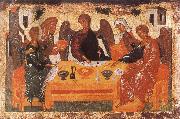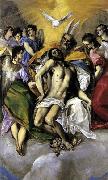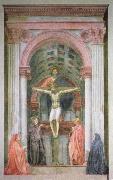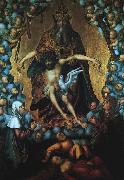Wholesale Oil Painting No Minimum |
|||||||||||
|
|
|||||||||||

|
|||||||||||
|
|
|
||||||||
Lucas Cranach1472-1553 German Lucas Cranach Locations Lucas Cranach the Elder was born at Kronach, Franconia. He was apparently trained by his father, Hans, a painter, and from 1495 to 1498 undertook work at Kronach for Coburg and Gotha. There is evidence that Cranach resided in Vienna between about 1500 and 1504. In 1504 he married Barbara Brengbier of Gotha; they had three daughters and two sons, Hans (died 1537) and Lucas the Younger (1515-1586), both of whom were painters. In 1505 Cranach established residence at Wittenberg, where he was court painter to three successive electors: Frederick the Wise, John the Constant, and John Frederick the Magnanimous. Cranach was a prosperous and respected citizen. He owned several houses and land, held the office of councilor, and was a burgomaster. He also worked for other princely patrons and was a follower and lifelong friend of Martin Luther. In 1550 Cranach followed John Frederick the Magnanimous to Augsburg, where the elector was in exile, and in 1552 accompanied him to Weimar. Cranach died in Weimar on Oct. 16, 1553. |
||||||||
|
|
||||||||
The Trinity
The Trinity Painting ID:: 651 |
Museum der Bildenden Kunste, Leipzig Museum der Bildenden Kunste, Leipzig |
|||||||
|
|
||||||||
|
|
||||||||
|
|
The Trinity
The Trinity Painting ID:: 41829 |
mk165
1425
Tempera on plaster on canvas mounted on wood
36x54.2cm
mk165 1425 Tempera on plaster on canvas mounted on wood 36x54.2cm |
||||||
|
|
||||||||
Lucas Cranach1472-1553 German Lucas Cranach Locations Lucas Cranach the Elder was born at Kronach, Franconia. He was apparently trained by his father, Hans, a painter, and from 1495 to 1498 undertook work at Kronach for Coburg and Gotha. There is evidence that Cranach resided in Vienna between about 1500 and 1504. In 1504 he married Barbara Brengbier of Gotha; they had three daughters and two sons, Hans (died 1537) and Lucas the Younger (1515-1586), both of whom were painters. In 1505 Cranach established residence at Wittenberg, where he was court painter to three successive electors: Frederick the Wise, John the Constant, and John Frederick the Magnanimous. Cranach was a prosperous and respected citizen. He owned several houses and land, held the office of councilor, and was a burgomaster. He also worked for other princely patrons and was a follower and lifelong friend of Martin Luther. In 1550 Cranach followed John Frederick the Magnanimous to Augsburg, where the elector was in exile, and in 1552 accompanied him to Weimar. Cranach died in Weimar on Oct. 16, 1553. |
||||||||
|
|
||||||||
|
|
The Trinity
The Trinity Painting ID:: 51722 |
nn09
Oil on wood
55x39in
nn09 Oil on wood 55x39in |
||||||
|
|
||||||||
El GrecoGreek-born Spanish Mannerist Painter, 1541-1614 Considered a representative of late Renaissance Spanish art, El Greco was actually born in Greece, on the island of Crete. After studying in Venice under Titian, El Greco settled in Toledo, Spain in 1577. At the time he was wildly popular, his emotionally religious paintings being just the ticket for the hometown of the Spanish Inquisition. After his death his work was largely ignored until the beginning of the 20th century; now he considered one of the inspired geniuses of Western art. His distinctive style features bold shapes and colors, with elongated and slightly distorted figures. In Toledo El Greco was in constant demand and liked living large: he maintained a private orchestra to accompany his meals. |
||||||||
|
|
||||||||
|
|
The Trinity
The Trinity Painting ID:: 52637 |
1577 Oil on canvas, 300 x 179 cm 1577 Oil on canvas, 300 x 179 cm |
||||||
|
|
||||||||
MASACCIOItalian Early Renaissance Painter, 1401-1428 was the first great painter of the Quattrocento period of the Italian Renaissance. His frescoes are the earliest monuments of Humanism, and introduce a plasticity previously unseen in figure painting. The name Masaccio is a humorous version of Tommaso, meaning "big", "fat", "clumsy" or "messy" Tom. The name was created to distinguish him from his principal collaborator, also called Tommaso, who came to be known as Masolino ("little/delicate Tom"). Despite his brief career, he had a profound influence on other artists. He was one of the first to use scientific perspective in his painting, employing techniques such as vanishing point in art for the first time. He also moved away from the Gothic style and elaborate ornamentation of artists like Gentile da Fabriano to a more natural mode that employed perspective for greater realism. Masaccio was born to Giovanni di Mone Cassa??i and Jacopa di Martinozzo in Castel San Giovanni di Altura, now San Giovanni Valdarno (now part of the province of Arezzo, Tuscany). His father was a notary and his mother the daughter of an innkeeper of Barberino di Mugello, a town a few miles south of Florence. His family name, Cassai, comes from the trade of his grandfather Simone and granduncle Lorenzo, who were carpenters - cabinet makers ("casse", hence "cassai"). His father died in 1406, when Tommaso was only five; in that year another brother was born, called Giovanni after the dead father. He also was to become a painter, with the nickname of "Scheggia" meaning "splinter". The mother was remarried to an elderly apothecary, Tedesco, who guaranteed Masaccio and his family a comfortable childhood. |
||||||||
|
|
||||||||
|
|
The Trinity
The Trinity Painting ID:: 55928 |
mk247
1428,fresco,262.5x124.875 in,667x317 cm,santa maria novella,florence,ltaly mk247 1428,fresco,262.5x124.875 in,667x317 cm,santa maria novella,florence,ltaly |
||||||
|
|
||||||||
Lucas Cranach the Elderb. 1472, Kronach, d. 1553, Weimar. German painter and printmaker. He took his name from the town of his birth. Little is known about his early life or training. In Vienna (c. 1501 ?C 04) he painted some notable portraits and landscapes characteristic of the Danube school. From 1505 to 1550 he was court painter in Wittenberg, where he achieved great success and wealth painting portraits, mythological subjects, and altarpieces for Protestant and Catholic churches. He attracted so many young artists to Wittenberg that the town became an art centre. A friend of Martin Luther, Cranach became known as the chief pictorial propagandist of the Protestant cause in Germany. He produced numerous engravings and more than 100 woodcuts, notably for the first German edition of the New Testament (1522). After his death, his style was perpetuated by his son, Lucas the Younger (1515 C 86). |
||||||||
|
|
||||||||
|
|
The Trinity
The Trinity Painting ID:: 97778 |
first half of 16th century
Medium oil on panel
cyf first half of 16th century Medium oil on panel cyf |
||||||
|
|
||||||||
|
Lucas Cranach the Elder b. 1472, Kronach, d. 1553, Weimar. German painter and printmaker. He took his name from the town of his birth. Little is known about his early life or training. In Vienna (c. 1501 ?C 04) he painted some notable portraits and landscapes characteristic of the Danube school. From 1505 to 1550 he was court painter in Wittenberg, where he achieved great success and wealth painting portraits, mythological subjects, and altarpieces for Protestant and Catholic churches. He attracted so many young artists to Wittenberg that the town became an art centre. A friend of Martin Luther, Cranach became known as the chief pictorial propagandist of the Protestant cause in Germany. He produced numerous engravings and more than 100 woodcuts, notably for the first German edition of the New Testament (1522). After his death, his style was perpetuated by his son, Lucas the Younger (1515 C 86). The Trinity first half of 16th century Medium oil on panel cyf |
||||||||
|
|
||||||||
|
Prev Next
|
||||||||
|
|
||||||||
|
Related Paintings to Lucas Cranach the Elder :. |
||||||||
|
|
||||||||
|
CONTACT US |






